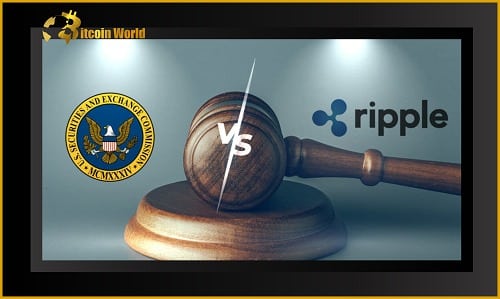The crypto world is watching the ongoing legal saga between Ripple (XRP) and the Securities and Exchange Commission (SEC) with bated breath. Why? Because this isn’t just another crypto squabble – it’s a landmark case that could set precedents for the entire digital asset industry. Recently, things have heated up again, with Ripple challenging the SEC’s latest move to access previously undisclosed legal documents. Let’s dive into what’s happening and why it matters for XRP holders and the broader crypto community.
What’s the Latest Spark in the Ripple vs. SEC Fire?
As defense attorney James K. Filan, a prominent voice in the XRP community, recently highlighted, Ripple has officially filed an Opposition to the SEC’s request. This opposition is aimed at Judge Netburn’s deliberative process privilege (DPP) Ruling. In simpler terms, the SEC is attempting to get their hands on notes penned by Matthew Estabrook, who was legal counsel to former SEC Commissioner Elad Roisman. But Ripple isn’t backing down, arguing that the SEC is essentially trying to get a ‘do-over’ in their legal strategy.
Why Are These Estabrook Notes Causing Such a Stir?
To understand the current standoff, we need to rewind a bit. The crux of the matter revolves around two memos, one from February 2012 and another undisclosed memo. Ripple believes these documents are crucial because they demonstrate that there was a strong internal argument within the SEC itself that XRP tokens might *not* be classified as securities under federal law. By bringing these memos to light, Ripple aims to show how they sought and interpreted regulatory guidance at the time, essentially arguing they acted in good faith.
These notes in question were taken during a meeting in 2018 between Elad Roisman and Ripple CEO Brad Garlinghouse. Interestingly, they surfaced in January 2022, quite by chance, when Estabrook was tidying up his desk before leaving the SEC. Talk about timing!
Ripple’s Stance: Transparency vs. Privilege
The SEC initially invoked deliberative process privilege (DPP) to withhold the Estabrook notes, arguing they were internal and confidential. Ripple, however, contests this claim. They argue that these notes are not protected under DPP and should be made public. Why?
- Public Interest: Ripple believes transparency is paramount, especially in a case with such significant implications for the crypto industry. Making these notes public contributes to a clearer understanding of the SEC’s internal deliberations and thought processes regarding cryptocurrency regulation.
- Challenging Regulatory Ambiguity: Ripple contends that the SEC’s own documents reveal an acknowledgment of the ‘legal purgatory’ created by regulatory ambiguity surrounding cryptocurrencies. They point to the fact that the SEC documented CEO Brad Garlinghouse’s exit from the 2018 meeting, suggesting the SEC was aware of the uncertainty they were creating.
- Fairness and Disclosure: Ripple is essentially saying, ‘You can’t claim privilege when these documents are vital to our defense and shed light on your own internal discussions about XRP’s regulatory status.’
The Court of Public Opinion and the Legal Battlefield
By making the original 2012 memo and the second memo public, Ripple isn’t just fighting in the courtroom. They’re also engaging in the court of public opinion. They are proactively revealing information that supports their narrative and puts pressure on the SEC to be more transparent. This strategy resonates strongly with the XRP community and the wider crypto space, who are keenly observing every twist and turn in this case.
What Does This Mean for XRP Price and the Future?
The Ripple lawsuit has been a major factor influencing XRP’s price volatility and market sentiment. Positive developments in the case are often seen as bullish signals for XRP, while negative news can trigger price drops. The current opposition by Ripple is being viewed by many in the XRP community as a positive step, reinforcing Ripple’s determination to fight back against the SEC’s allegations.
Key Takeaways from the Latest Development:
| Aspect | Significance |
|---|---|
| Ripple’s Opposition | Demonstrates Ripple’s continued aggressive defense and challenges the SEC’s attempts to withhold documents. |
| Estabrook Notes | Could reveal SEC’s internal discussions and potentially support Ripple’s argument that XRP’s regulatory status was ambiguous. |
| Transparency Battle | Highlights the ongoing tension between regulatory bodies and crypto companies regarding information disclosure and regulatory clarity. |
| Market Impact | Further developments in the lawsuit, like this opposition, can influence XRP price and investor confidence. |
Looking Ahead: What’s Next in the Ripple vs. SEC Saga?
The legal battle is far from over. Judge Netburn will now need to consider Ripple’s opposition and decide whether the SEC must hand over the Estabrook notes. The outcome of this particular dispute could have implications for the broader case. The XRP community and crypto enthusiasts will be closely watching for the court’s decision and any further filings in this high-stakes legal drama.
In Conclusion: The Ripple Lawsuit – A Crypto Industry Bellwether
The Ripple vs. SEC lawsuit is more than just a legal dispute between two entities. It’s a defining moment for the cryptocurrency industry, with potential ramifications for regulatory clarity, innovation, and the future of digital assets. Ripple’s latest opposition underscores the complexities and the high stakes involved. As the case unfolds, it will undoubtedly continue to shape the narrative around crypto regulation and influence the trajectory of the market. Stay tuned for more updates as this crucial case progresses!
Related Posts – Ferrari joins the NFT universe through a collaboration with a Swiss…
Disclaimer: The information provided is not trading advice, Bitcoinworld.co.in holds no liability for any investments made based on the information provided on this page. We strongly recommend independent research and/or consultation with a qualified professional before making any investment decisions.


